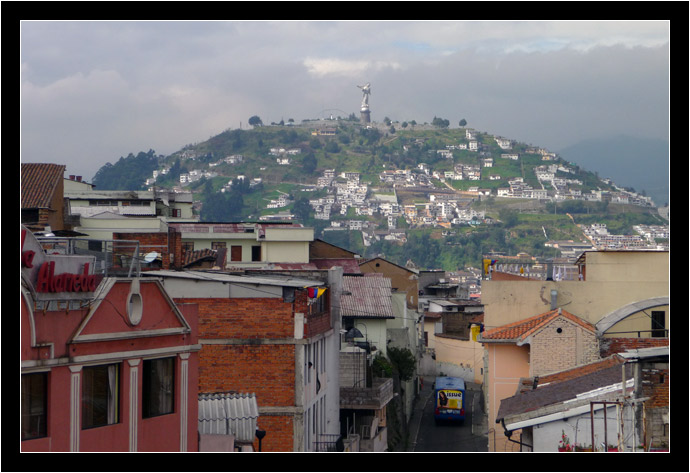Thoughts on Argentina II

Oksana and I visited Argentina for the first time in 2008 and I wrote up my initial thoughts about the country back then. We rented an apartment in Buenos Aires this time, and I thought that I would have noticed a ton more things, but my list this time is fairly short. That could be because first impressions are always the strongest, or it could be because we mostly hid out in our apartment the entire month (enjoying a kitchen we could cook in and a bed that didn’t have to be sought out after every night’s sleep!)
Tipping the Baggage Handler
The first new thing about Argentina, we noticed before ever leaving Chile. As we handed our big backpacks over to the baggage handler to stuff under the bus, he put his hand out and waited. Obviously he wanted a tip (we did notice other people paying him, but not how much.) Oksana handed over what Chilean change she had for the both of us – he kind of sniffed at it, but accepted it.
I thought it odd. I wasn’t sure what the tip was for, as he hadn’t done anything differently than the baggage handlers in the other four countries we’d visited.
Then, just before we reached the Chilean/Argentinean immigration checkpoint, high in the Andes, the baggage handler came walking down the aisle with a tin cup. People all along the bus were dropping more coins in. I was able to listen in to another curious tourist asking what it was for and he replied that it was a tip for the baggage handler.
That sounded very close to blackmail to me.
I relayed the answer to Oksana; she didn’t like it either. When he reached us, Oksana dumped all our remaining change onto the top of the pile in the cup – it was the equivalent of perhaps four pennies – and it was supposed to cover Oksana, Anna, and me. He looked into the cup, somehow managed to ascertain that she was short-changing him, and said to her, in Spanish, “Not enough.”
Oksana, defiant, started to ask, “¿Por qué?” and he explained himself as he did to the other tourist. Oksana began to argue with him in English, he argued right back in Spanish. Neither one knew what the other was saying. Finally she said, “No entiendo español,” and he fired back with “¡Y no hablo ingles!” The ultimate “let’s agree to disagree.”
To add insult to injury, when we arrived in Mendoza and went to get our bags, the handler put his hand out yet again for tip. Three times for the same bus ride, just to keep our bags “safe!” By that point the bags were in our sight and there was no way anything would be stolen from us if we didn’t pay him. We turned and walked away. Besides, we were tapped out.
At least after going through the border crossing, I realized what the guy with the tin cup was getting at. While we were in line at immigration, all our bags were gathered up and taken to customs. If no one had been watching them, the customs officials might have been tempted to remove one or two items from our bags. I guess all it takes to stop that sort of behavior is a surly, well-tipped baggage handler standing over them.
National Coin Shortage
We never noticed this in 2008, so it may be something new. Coins are in extremely short supply in Argentina.
Here’s the problem: The municipal buses in Argentina are the cheapest form of public transportation and (aside from buying multiple-use cards) they only accept change. Because of that, everyone hoards their change for the buses. And because of that, it’s practically impossible to impulsively decide to take the bus.
You can go to the bank, of course, and exchange some paper money for coins, but God forbid you ever find yourself in a bussing moon on a Sunday. Once, three of us wanted to take a bus to a mall on the outskirts of Mendoza. We spent at least a half hour, going from shop to shop, asking cashiers to break some bills for us. We even went to McDonald’s, offered to buy something, and the girl behind the counter said she had 25 centavos. Misunderstanding her, I said that’s fine, we’d only need about 4 quarters per person. “No,” she said, “I have only 25 cents in the till.”
A kind woman standing nearby took pity on us and changed as much as she could, 2 pesos. We still needed one more to get all three of us to the mall. We ended up taking a cab.
An interesting way in which this problem manifests itself is in what you can be offered instead of change. We were at the movie theater and I bought a package of M&Ms. 13 pesos, I paid with a twenty. As the concession stand girl was fishing for my change, she held up one of those foil-wrapped chocolate coins and asked if I’d like a piece of candy. Um, okay. Sure, thanks. It was only afterwards that I realized she only handed me back a five in change. That piece of candy cost me half a bus ticket.
Popcorn
Speaking of movie theaters, you can order just as big a tub of popcorn as you can in the States. The only difference is that they don’t ask if you want it “buttered or unbuttered,” but rather “sweet or salty?” We found ourselves going for the sweet popcorn. If it’s not going to be smothered in butter, it might as well be dusted with super-fine sugar.
Eggs
I don’t know why I didn’t realize this until now, because it’s not unique to Argentina, but so many places in Latin America don’t refrigerate their eggs. I guess they can stay fresh up to a month (or longer, depending on the temperature – but not too warm or they’ll incubate!) It makes sense if you think about it. If Chicken eggs had to be refrigerated, they would go bad as soon as they were laid.
Sales Tax
When you leave Argentina via the airport, you have the opportunity to have some of the sales tax you’d paid on purchases refunded to you. I don’t know why I forget to mention this in my previous post, because we took advantage of it ourselves, back in 2008.
Basically, it works like this: Store where you can buy some of the bigger ticket items – like wine, leather products, expensive tourist souvenirs, things like that –give you a receipt declaring the sales tax amount you paid. If you hang on to those receipts, there’s a booth at the airport where you can get that tax refunded just before you leave the country. The process has been streamlined a bit since we were there the first time. You used to have to gather everything together and drop the bundle into a mail box, then wait a month or two to before you saw the refund on your credit card statement. Now they simply reimburse your credit card while you wait.
It’s an international version of a process we’re familiar with in the States. Typically, you don’t have to pay sales tax on things sold in states you don’t live in. This is why you don’t have to pay sales tax on most of the items you buy on the internet.
Garbage Collection
Picture this: A trash bin in the shape of a basket, made of maybe eight pieces of iron rebar, situated at about chest level, balanced on a single pole of slightly thicker rebar. Many of the garbage bins along the streets in Argentina are designed just like that, and in the evenings people pile their bags of garbage up in them until they’re about to topple over.
These garbage baskets bothered the heck out of me every time I found myself walking along with an empty bottle or candy wrapper in my hand. There was no way to put anything small in them without it falling through the gaps between the rebar. Despite being on practically every street, they’re not at all a solution to the litter problem.
I’ve seen this style of garbage basket all through Latin America, too, but it wasn’t until Argentina that it dawned on me why they were made that way.
It’s the stray dogs. By keeping the garbage off the ground, balanced on a thin pole that dogs can’t possibly climb, it keeps most of the garbage from being torn apart and dragged through the streets.
Cartoneros
At night, on Corrientes Avenue (where we rented an apartment), everything is a mess. People from the high-rise apartment buildings bring all their garbage down to the street and leave their plastic bags sitting on the sidewalk. Before long, the bags have been cut open and the contents strewn all over the sidewalk, curb, and parts of the street. Every morning, however, everything was tidy and clean again. What the heck was going on?
I started to be more observant when we walked home after dark and noticed people rooting through the garbage for stray pieces of cardboard. Was the recycling so valuable to make it worth someone’s time to search everyone’s garbage? Apparently so.
When I asked our local friends what was going on, they smiled. It’s a long story.
You see, Buenos Aires has a cardboard recycling program, but cries of limited resources, going green, and carbon footprints mostly fall on deaf ears. The average Porteño can’t be bothered to sort their own garbage.
In order to get cardboard – presumably the most cost-effective item to recycle – out of the garbage and into the recycling plants, Buenos Aires decided to pay a minimal price for cardboard by the kilo. Unfortunately, it wasn’t enough to entice people to sort their trash, but it was enough to make it worthwhile for some of the lower class to go through it for them.
Enter the “cartoneros.” These ladies and gentlemen work exclusively at night, slicing open bags and looking through them for any packaging boxes they can get their hands on. Later on they push and carry huge bundles of cardboard down the street, some as large as small cars. I have no idea what they do with them after that; presumably someone comes around and collects it, weighing the haul and giving them a cut of the recycling return.
They left such a mess on the streets, though; I couldn’t quite get a handle on why they were allowed to continue.
“Oh, it gets more complicated,” my friends told me.
You see, the municipal garbage men have to come around every night in their big garbage trucks. They collect all the trash from those crazy rebar bins and pick up any intact bags left on the curbs, but they won’t touch what the cartoneros have spread all over the sidewalks and streets.
I can understand that. I can even respect them for taking a stand. They have strong labor unions in Argentina and they probably argued that they were hired to be garbage men, not street cleaners.
“But who cleans everything up?” I asked. “It’s all gone in the morning!”
“Well, the government appointed another group to clean up the stuff the garbage men wouldn’t pick up…”
“What? Why don’t they just put a stop to the cartoneros, make it illegal to—“
“Oh, no! No, no, no! The cartoneros are protected now! Not too long ago there were a couple incidents where cartoneros, working late at night and wearing dark clothing, were killed in car accidents while they were crossing the street,” my friend explained. “Now the city pays to provide all of them with reflective jackets and gloves so that they can do their work in relative safety.”
Try as I might, I couldn’t understand how the whole system could be allowed to continue (let alone be functional and profitable.) Another friend described it as a band-aid on a band-aid on a band-aid. The Argentineans thought there was a good chance that the mafia was involved.
I kept asking, “How?” “But how?” “Why, how, why?!”
Finally, my friend from Buenos Aires smiled and raised her hand to stop me. “It’s the Argentinean way,” she said.







